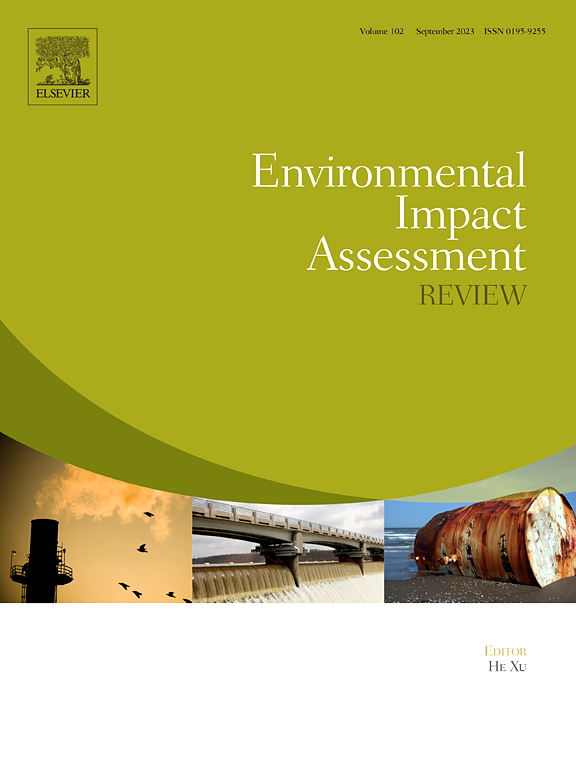日本水泥生产和消费引发的“资源-碳”再分配:基于生命周期的多层视角
IF 9.8
1区 社会学
Q1 ENVIRONMENTAL STUDIES
引用次数: 0
摘要
日本水泥供应链内的原材料、能源和产品的区域间贸易创造了大量的材料和碳流。区域水泥消费和供应链结构的时间动态对生产区域和资源供应商的影响存在差异。然而,现有的文献研究主要集中在单年碳流量和模糊的运输影响。因此,本研究开发了一个基于过程的生命周期多层供应网络,整合了运输数据、贸易统计和重力模型,以量化2010年至2022年日本县级水泥供应网络中的材料和碳流。结果显示,到2022年,高达88%的总材料需求(TMR)和74%的碳足迹(CF)影响归因于县际贸易和能源进口,而运输过程约占总影响的5%。在国内,TMR和CF转移主要从北部地区(北海道、岩手县)和南部地区(福冈、山口、高知县)向三个主要经济中心流动,而较小的转移网络则在埼玉县、新泻县和三重县周围出现。由于远程消费减少,主要影响出口县的生产侧TMR和CF最近有所下降,而兵库县在供应增加的推动下略有增长。在国际上,大约38%的TMR影响外化到煤炭出口国,澳大利亚和印度尼西亚在地缘政治变化后取代了俄罗斯的历史主导地位,导致远程海上影响增加了22%。这些调查结果强调,需要实施有针对性的跨领域缓解战略(即低碳燃料和材料高效设计),以在日本实现更具可持续性和弹性的水泥工业。本文章由计算机程序翻译,如有差异,请以英文原文为准。

“Resource-carbon” redistribution caused by Japan's cement production and consumption: a life-cycle based multilayer perspective
Inter-reginal trade of raw materials, energy, and products within Japan's cement supply chain creates substantial telecoupled material and carbon flows. Temporal dynamics in regional cement consumption and supply chain structure have discrepant effects on production regions and resource suppliers. However, existing literature studies primarily focused on single-year carbon flows and obscured transportation impacts. Therefore, this study developed a process-based life cycle multi-layer supply network integrating transport data, trade statistics, and gravity model to quantify material and carbon flows embedded in Japan's prefectural cement supply network from 2010 to 2022. Results reveal that in 2022, up to 88 % of total material requirement (TMR) and 74 % of carbon footprint (CF) impacts attributed to inter-prefectural trade and energy imports, while transportation processes contributed about 5 % to the total impacts. Domestically, TMR and CF transfers primarily flowed from northern regions (Hokkaido, Iwate) and southern regions (Fukuoka, Yamaguchi, Kochi) toward three major economic centers, while smaller transfer networks emerged around Saitama, Niigata, and Mie prefectures. The production-side TMR and CF of major impact-exporting prefectures have recently declined due to reduced remote consumption, while Hyogo demonstrated slight growth driven by supply increases. Internationally, approximately 38 % of TMR impacts were externalized to coal-exporting countries, with Australia and Indonesia replacing Russia's historical dominance following geopolitical changes, leading to a 22 % increase in long-distance maritime impacts. These findings underscore the need for implementing targeted cross-cutting mitigation strategies (i.e., low-carbon fuels and material-efficient design) to achieve a more sustainable and resilient cement industry in Japan.
求助全文
通过发布文献求助,成功后即可免费获取论文全文。
去求助
来源期刊

Environmental Impact Assessment Review
ENVIRONMENTAL STUDIES-
CiteScore
12.60
自引率
10.10%
发文量
200
审稿时长
33 days
期刊介绍:
Environmental Impact Assessment Review is an interdisciplinary journal that serves a global audience of practitioners, policymakers, and academics involved in assessing the environmental impact of policies, projects, processes, and products. The journal focuses on innovative theory and practice in environmental impact assessment (EIA). Papers are expected to present innovative ideas, be topical, and coherent. The journal emphasizes concepts, methods, techniques, approaches, and systems related to EIA theory and practice.
 求助内容:
求助内容: 应助结果提醒方式:
应助结果提醒方式:


